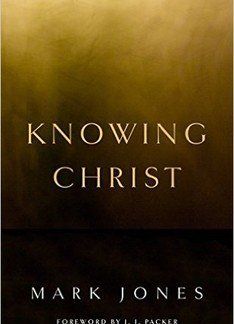Shortly after becoming a Christian, Mark Jones read J. I. Packer’s Knowing God. This book made a profound impact on him, and Knowing Christ is something of a follow-up to Packer’s classic. Packer himself writes an enthusiastic foreword to the book.
There is no doubting the aim and desire of the author. He makes this challenging observation: ‘There is little doubt that almost all Christians are content to have won Christ and thus to have received the gift of eternal life. But how many are equally concerned to know him?
‘How often we cut Jesus in half, wishing to know that we are saved and that all is well with our destiny, but forgetting that to be truly saved means we must truly know him’ (p.2). Jones writes in order ‘that people may know Christ better than they already do and so love him more’.
With that in mind, he divides his book into 27 short chapters. Topics include ‘Christ’s emotions’, ‘Christ’s growth’, ‘Christ’s sinlessness’, ‘Christ’s temptations’, ‘Christ’s death’, ‘Christ’s resurrection’ and ‘Christ’s church’. The chapters on Christ’s sinlessness and temptations were especially illuminating.
Throughout, Jones quotes from the Puritans, but the majority of his references are from Scripture. This surely must be right, as the biblical text is the supreme means by which we increase our knowledge of Christ. If some of the Puritan quotes are memorable, then so too are some of the author’s. To give a flavour of the book, I can do no better than quote a few examples:
‘If Adam’s decision to go to the tree would bring ruin to the human race, the resolve of the last Adam to “go to the tree” would bring salvation to the human race’ (p.82); ‘the Jews picked up stones to throw at him. Little did they know that they were attempting to stone the very Rock of Ages’ (p.121); ‘it should humble us to think that, for a time, God showed more love to us than he did to his own Son, who became a curse for us’ (p.124).
‘God was never more happy with his Son than when he was most angry with him’ (p.147); ‘in the Gospel of Mark, Christ makes three explicit predictions of his death and resurrection. These forecasts are so clear that they leave us wondering why the disciples were not waiting outside the tomb on Sunday morning to greet their triumphant Saviour’ (p.163).
‘Jesus was not sitting but standing when Stephen saw him. Why? Stephen stood up for Jesus; he held fast to his confession. As a result, Jesus stood for Stephen’ (p.182); ‘the saints of God can be a real stumbling block to belief. Without us, the gospel would be easier to believe. But God has not ordered matters that way. He has ordained the church for his Son, “warts and all”’ (p.185).
Jones says, ‘this is a book for God’s people, not the academy’, but nevertheless there is a rich mix here of the theological and the devotional. For this reason, it may not be the best book to give to a new convert.
Nonetheless, I have no hesitation in recommending it to anyone wanting a deeper appreciation of the Saviour. This reviewer often had cause to pause and to marvel afresh at ‘the unsearchable riches of Christ’. I hope Knowing Christ will endure in much the same way as Knowing God.
John Mollitt
Ingleton






